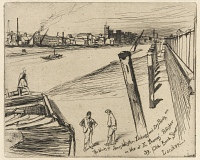Etchings Institutions search term: caxton club
Millbank | ||
| Number: | 78 | |
| Date: | 1861 | |
| Medium: | etching and drypoint | |
| Size: | 102 x 127 mm | |
| Signed: | 'James Whistler' (in inscription) (1-4); removed (5) | |
| Inscribed: | '1861' at lower left; 'The Works of James Whistler: Etchings and Dry Points, are on View at E. Thomas' .. Publisher / 39. Old Bond Street' at lower right (1-2); 'London.' added (4); erased (5) | |
| Set/Publication: | 'Thames Set', 1871 | |
| No. of States: | 5 | |
| Known impressions: | 67 | |
| Catalogues: | K.71; M.71; T.44; W.67 | |
| Impressions taken from this plate (67) | ||
PUBLICATION
EXHIBITIONS
 ,
,  ).
). Lochnan discussed the use of this etching as an advertisement:
12: London Thomas 1861 .
13: Pennell 1921C , f. p. 35.
14: Lochnan 1984 , p. 126.
 ,
,  ). 15 Impressions went to international exhibitions, including the World's Columbian Exposition in 1893. It was also shown in an exhibition organised by the Caxton Club in Chicago in 1900, lent by Bryan Lathrop (1844-1916) (
). 15 Impressions went to international exhibitions, including the World's Columbian Exposition in 1893. It was also shown in an exhibition organised by the Caxton Club in Chicago in 1900, lent by Bryan Lathrop (1844-1916) ( ). 16
). 16
15: New York 1881 (cat. nos. 94-5). See REFERENCES : EXHIBITIONS.
16: Chicago 1900 (cat. no. 62).
Finally, impressions were shown after Whistler's death in the comprehensive exhibition at the Grolier Club in New York in 1904, and, lent from the Royal Collection, one was included in the London Memorial Exhibition of 1905. 18
17: New York 1898 (cat. no. 64); London Obach 1903 (cat. nos. 69, 70, 71).
18: New York 1904a (cat. no. 69); London Mem. 1905 (cat. no. 67).
SALES & COLLECTORS
 ). It was later bought by Samuel Putnam Avery (1822-1904). Impressions of the second (
). It was later bought by Samuel Putnam Avery (1822-1904). Impressions of the second ( ) and fourth (
) and fourth ( ) states went to Francis Seymour Haden, Sr (1818-1910).
) states went to Francis Seymour Haden, Sr (1818-1910). 19: Sotheby's, 12 June 1877 (lots 95 and 104); 22 April 1887 (lot 199); 9 December 1889 (lot 317).
 ).
).20: Christie's, 3 March 1892 (lots 119 - 120); 8-9 March 1892 (lot 31).
21: Sotheby's, 15 December 1896 (lot 271), bought by E. Parsons.
 ), William Ernest Henley (1849-1903) (
), William Ernest Henley (1849-1903) ( ), and David Roberts RA (
), and David Roberts RA ( ). Inscribed impressions and those from important early collections tended to gravitate to other major collections. Thus an impression owned by Francis Seymour Haden, Sr (1818-1910), was acquired first by Howard Mansfield (1849-1938), and then by Lessing Julius Rosenwald (1891-1971) (
). Inscribed impressions and those from important early collections tended to gravitate to other major collections. Thus an impression owned by Francis Seymour Haden, Sr (1818-1910), was acquired first by Howard Mansfield (1849-1938), and then by Lessing Julius Rosenwald (1891-1971) ( ) who gave it to the National Gallery of Art in Washington DC.
) who gave it to the National Gallery of Art in Washington DC. ); Gerald Potter (1829-1908) (
); Gerald Potter (1829-1908) ( ); James A. McCallum (1862-1948) (
); James A. McCallum (1862-1948) ( ); and Guy John Fenton Knowles (1879-1959) (
); and Guy John Fenton Knowles (1879-1959) ( ).
). ). Freer also bought a fourth state from Keppel in 1898 (
). Freer also bought a fourth state from Keppel in 1898 ( ).
).
